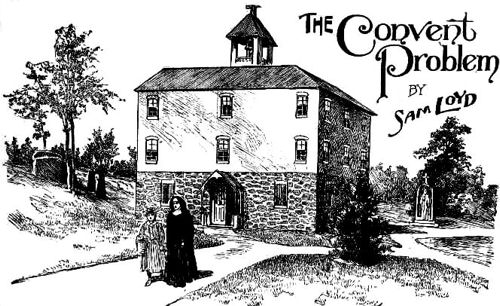



AS PERTINENT TO A reference to unsolved, or ancient puzzles the true conditions of which seem never to have been correctly understood, I wish to call attention to one which is popularly known as the Problem of the Nuns. It appears in almost all collections of puzzles, but is very childish and the answer too weak to satisfy the expectations of solvers.
I remember that the answer was very disappointing when I first saw it many years ago, and I recall the accompanying statement about its being of Spanish origin and founded on an incident which occurred many centuries ago. Recently I came into possession of some very old Spanish histories, in one of which I find a brief allusion to the convent of Mt. Maladetta, situated on the mountain of that name, mentioned as being the highest peak of the Pyrenees. Reference is made to the occupancy of that part of the country by the French invaders who were finally defeated and driven out through that famous pass which was the scene of many contentions for over a century.
The direct allusion to the puzzle, however, occurs in the passage which says: “Many of the nuns were carried away by the ‘Frank’ soldiers, which without doubt gave rise to the familiar problem of the nuns of the convent of Mt. Maladetta.”
As no explanation of the puzzle is vouchsafed, and the popular version is so susceptible of double solutions. I take the liberty of presenting it in a form which preserves the spirit of the problem and at the same time eliminates the many other answers.
The convent as shown in the picture, was a square three-story structure, with six windows on each side of the upper stories, it is plain to be seen that there are eight rooms on each of the upper floors, which agrees with the requirements of the old story. As the legend goes, the upper floors were used for sleeping apartments, of which the top floor, having more beds in each of the rooms, accommodated twice as many occupants as the second floor.
The mother Superior, in accordance with an old rule of the founders. Insisted that the occupants must be so divided or arranged that every room should be occupied; there should be twice as many on the top floor as on the second, and that there must always be neither more nor less ‚Ä” just eleven nuns in the six rooms on each of the four sides of the convent. Of course it is plain to be seen that, the problem pertains to the two upper floors, so that the ground floor does not have to be considered at all.
Well, it so happened that after the retreat of the French army through the Pyrenees pass, that nine of the youngest and most comely nuns were found to have disappeared. And it was always believed that they had been captured by the soldiers. Not to distress the mother Superior, however, the nuns who discovered the loss found that it was just possible to conceal the fact, by a judicious manipulation or change of the occupants of the rooms, a maneuver with which they had long been familiar, as when at times it became necessary to conceal the absence of some of their more zealous workers.
So they managed to readjust themselves in such a way, that when the mother Superior made her nightly rounds, every room was found to be occupied; eleven nuns on each of the four sides of the convent; twice as many on the top floor as on the second, and yet the nine nuns were missing. How many nuns were there and how were they arranged?
The merit of the puzzle lies in the paradoxical conditions of the problem, which strikes us at the first blush to be absolutely impossible. Nevertheless it yields so readily to experimental puzzle methods, when one knows there is an answer, that our, puzzlists will find it an amusing and instructive lesson.
Now, regarding that bit of Spanish legendary, the puzzle being to show how the eight rooms were occupied, so that there should be eleven persons on each side of the house, with twice as many on the top floor, it can be shown as follows:
Top Flr 2nd Flr
1 5 1 1 2 1
5 5 2 2
1 5 1 1 2 1
After the nine were carried off, the rest were arranged as follows:
Top Flr 2nd Flr
3 2 3 1 1 1
1 1 1 2
4 1 3 1 1 1
Which shows eleven on all four sides in both instances.
[Page 75]